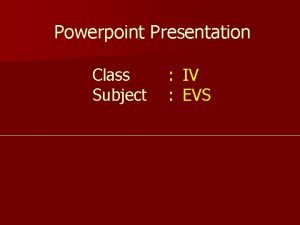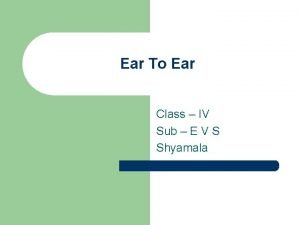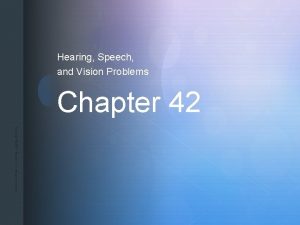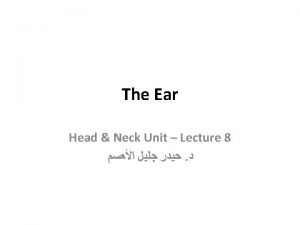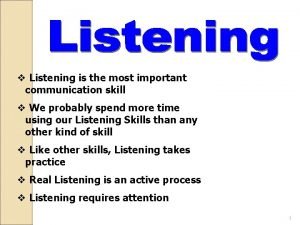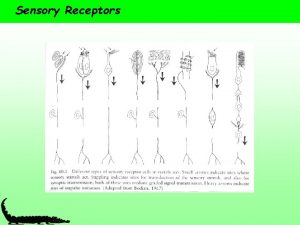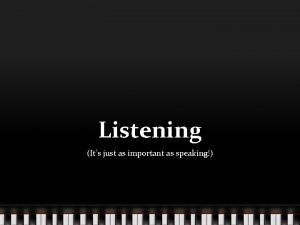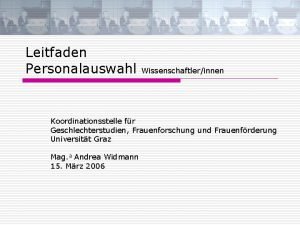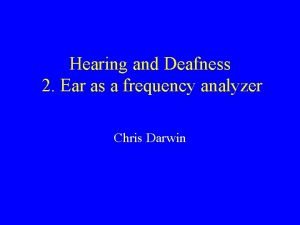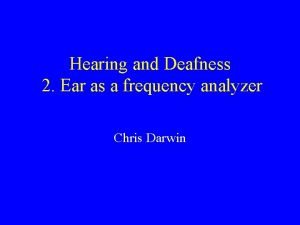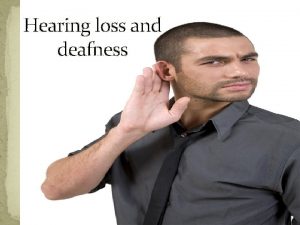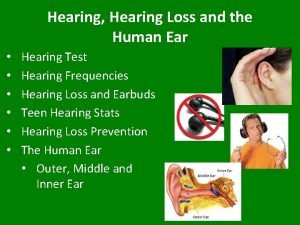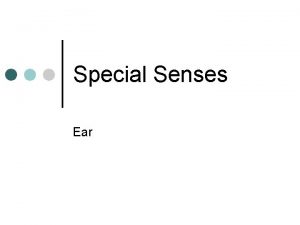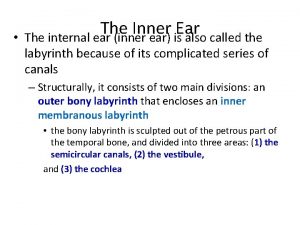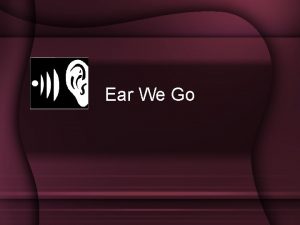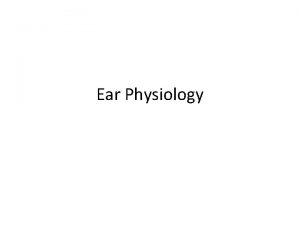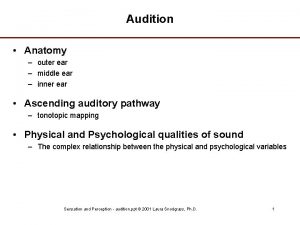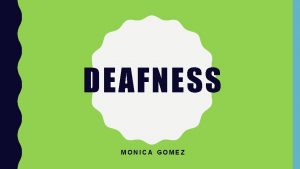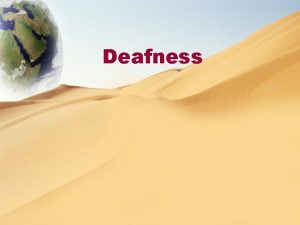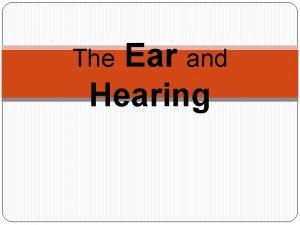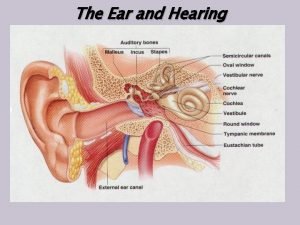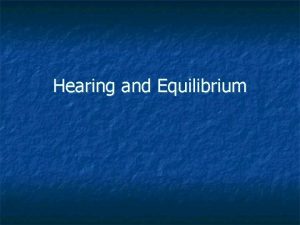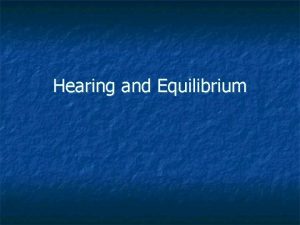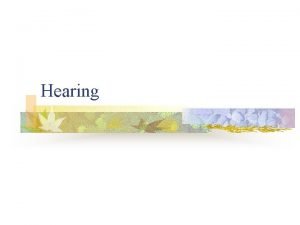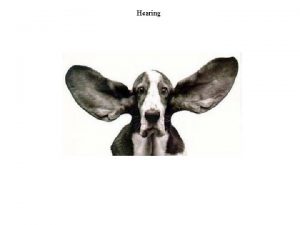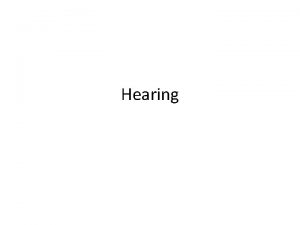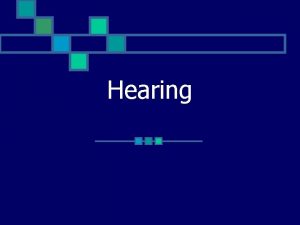Hearing and Deafness 2 Ear as a frequency



























- Slides: 27

Hearing and Deafness 2. Ear as a frequency analyzer Chris Darwin

Demo Class • Tuesday 24 th Oct 2006 at 12: 00 in CHI LT • Demonstration of Excel spreadsheet to illustrate: auditory filtering & excitation patterns. • Spreadsheet available at: http: //www. lifesci. sussex. ac. uk/home/Chris _Darwin/Perception/Lectures/ Amadeus

Frequency: 100 -Hz Sine Wave 1. 0 Spectrum 0 Amplitude against frequency -1. 0 0 Time (s) Waveform 0. 05 1 amp Amplitude against time 100 Hz frequency

Frequency: 500 -Hz Sine Wave 1. 0 Spectrum 0 Amplitude against frequency -1. 0 0 Time (s) 0. 05 1 Waveform amp Amplitude against time frequency 100 500 frequency

Amplitude: 500 -Hz Sine Wave Spectrum Amplitude against frequency 0 1 0 Time (s) 0. 05 amp frequency 100 0 0 Time (s) 0. 05 500 frequency

Phase: 500 -Hz Sine Wave sine The amplitude spectrum does not show phase 1 amp cosine frequency 100 500 frequency

adding sine waves Spectrum of Sum 1 Sine wave Sum 1 amp 0 ミ 11 frequency 0 ミ 11 1 0 amp ミ 1 0 0. 025 Time (s) 0. 05

100 -Hz fundamental Complex Wave 5. 0 Spectrum Amplitude against frequency 0 -1. 7 0 Time (s) Waveform 0. 05 1 amp Amplitude against time frequency 100 500 frequency

frequency -> Staggered sine-waves adding simultaneous staggered time ->

Bandpass filtering (narrow) 5. 0 1 amp 0 -1. 7 0 Time (s) 0. 05 frequency 100 500 frequency 1 amp 0 0 Time (s) 0. 05 frequency 100 500 frequency

Bandpass filtering (wide) 5. 0 1 amp 0 -1. 7 0 Time (s) frequency 100 0. 05 500 frequency 1 amp frequency 100

Beats Repetition rate is the difference in frequency between the two sine-wave components 1/100 th second 500 - 400 = 100 Hz 1 amp frequency 100 400 500 frequency

Excitation patterns (envelope of excitation) Basilar membrane excitation pattern is like a spectrum

Excitation pattern of complex tone on bm

Measurement of auditory bandwidth with band-limited noise 1000 Hz 250 Hz Broadband Noise frequency 2000 Hz Amadeus

A gardening analogy

A gardening analogy

A gardening analogy Tone Noise Auditory bandwidth Noise bandwidth Detection mechanism

Wider auditory filter

Psychophysical tuning curves Bandwidth Masker center frequency

Human auditory bandwidth 1000 SNHL 800 Normal 600 400 200 0 0 2000 4000 At 1 k. Hz the bandwidth is about 130 Hz; at 5 k. Hz the bandwidth is about 650 Hz. 6000 8000 BW = freq / 8 roughly

Normal auditory non-linearities • Normal loudness growth (follows Weber’s Law, which is logarithmic, not linear) • Combination tones • Two-tone suppression • Oto-acoustic emissions

Combinations Tones (Tartini tones) 1 amp frequency 800 1000 1200 frequency

Two-tone suppression

Conductive vs Sensori-neural deafness SNHL usually a combination of OHC and IHC damage BM response becomes linear, so • No combination tones • No two-tone suppression

Symptoms of SNHL • Raised thresholds: helped by amplification • Wider bandwidths: no help possible • Recruitment (restricted dynamic range): partly helped by automatic gain controls in modern digital aids • Other non-linearities also reduced: combination tones, two-tone suppression • Often accompanied by tinnitus

Normal vs Impaired Dynamic Range
 Icd 10 ear fullness
Icd 10 ear fullness Ear to ear class 4 evs ppt
Ear to ear class 4 evs ppt An animal with ear like leaves
An animal with ear like leaves Row conditional relative frequency
Row conditional relative frequency Expected relative frequency
Expected relative frequency Peak factor formula
Peak factor formula Vmax= aw
Vmax= aw Frequency vs relative frequency
Frequency vs relative frequency What is a marginal frequency
What is a marginal frequency Joint relative frequency
Joint relative frequency Chapter 42 hearing speech and vision problems
Chapter 42 hearing speech and vision problems Hearing and equilibrium
Hearing and equilibrium External auditory meatus
External auditory meatus Beach side sight
Beach side sight Barriers to listening
Barriers to listening Difference between hearing and listening
Difference between hearing and listening Bsc speech
Bsc speech Pseudo listening definition
Pseudo listening definition Barriers to communication
Barriers to communication We listen
We listen Types of thermoreceptors
Types of thermoreceptors What causes lady montague’s death?
What causes lady montague’s death? Hearing on advisement
Hearing on advisement Types of listening
Types of listening Hearing personalauswahl
Hearing personalauswahl I want to be different asl story
I want to be different asl story Kode icd gangguan pendengaran
Kode icd gangguan pendengaran Safetymri
Safetymri

